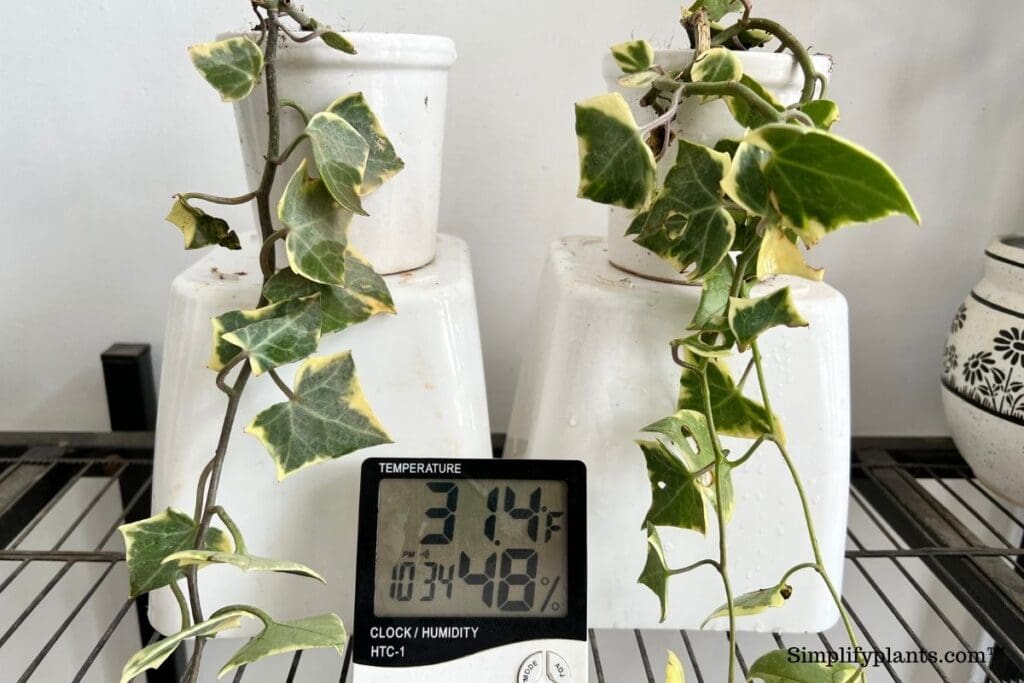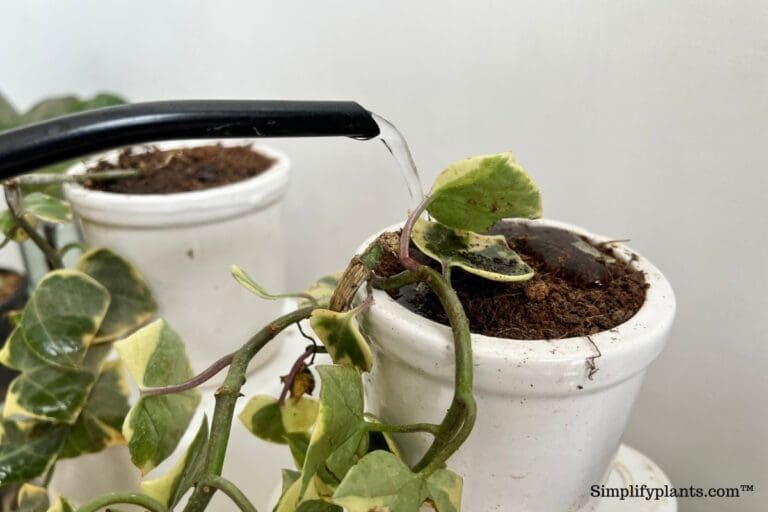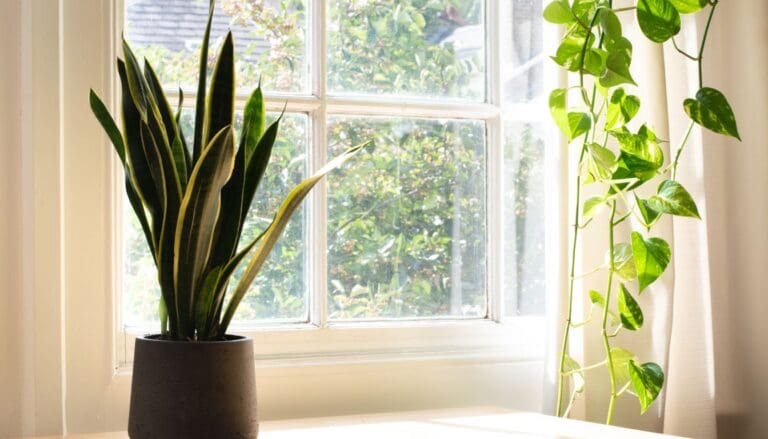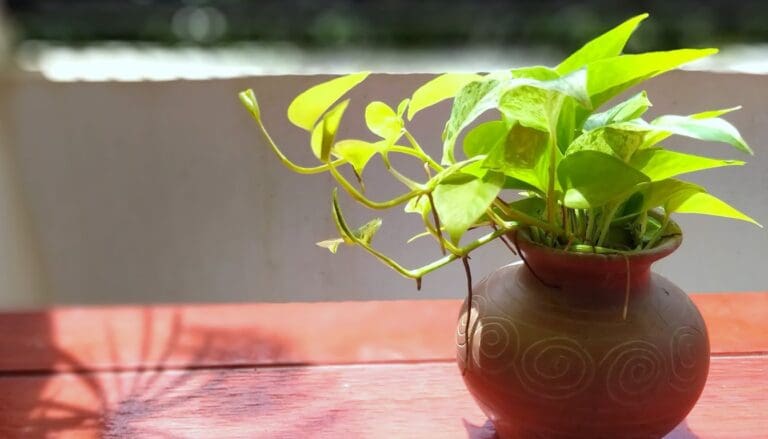How To Save Dying English Ivy? (8 Possible Problems+Solution)
English ivy plants are popular and grown indoors and outdoors across the US and the rest of the world. They are hardy plants but can die if exposed to unsuitable conditions for a prolonged period.
To save dying English ivy, you must:
- Examine the plant properly to find out the issue.
- Shift the plant to a bright spot.
- Reduce watering and let the soil dry out if it is overwatered.
- Take the ivy out of the pot and repot in fresh soil after removing the decaying roots in case of root rot.
- Stop adding fertilizers until the plant recovers.
- Spray the plant with a Neem oil solution to kill pests.
- Provide ideal temperatures and humidity levels.
This article will discuss the probable causes that can harm and kill your ivy. But don’t worry, I will also give possible remedies to treat the problems and save your ivy.

Please note: Simplify Plants is reader-supported. Some links in the post are affiliate links and I get a commission from purchases made through links in the post.
Signs of a dying English ivy
Before saving the ivy, you must identify the problem that the ivy is experiencing.
For this, you need to understand the signs of stress first.
Early detection of the problems can help save the plant, but it might get too late if you overlook them.
Some of the common signs of stress the English ivy shows are:
- The leaves fall off
- The leaves turn pale and yellow at the edges and then spread all over the leaves.
- The plant looks dry and crispy, and the leaves start to curl.
- The plant droops and wilts
- The leaves look mushy
- The growth rate of the plant slows, and it stops producing newer growth
- The leaves turn brown and shed leaves
These are some of the initial signs of stress in your English ivy.
If you notice these signs, take immediate action to rescue the plant.
Why is my English ivy dying?
English ivies are quite resistant to most minor issues and thus are considered to be one of the most popular beginner-friendly plants.
But since they are hardy, many plant growers make the mistake of ignoring them and not looking after their needs.
They expose the plant to incorrect temperatures, watering, lighting, etc.
Even if the plant is strong, it cannot stay healthy in such unsuitable conditions.
So if you keep your English ivy in the wrong conditions for a prolonged period, you may lose your plant.
Let me now explain the different causes that can lead to the death of your plant.
1. Overwatering

Overwatering is the most common cause of houseplants, including English ivies dying.
Watering, though a necessity for plants, overwatering can cause havoc and lead to numerous other problems.
English ivies like to grow in drier soil, which does not stay wet at all times.
If the soil stays wet for a long time, it will saturate the roots with water, restricting the airflow and giving rise to diseases.
When the oxygen supply to the roots is cut off, the roots fail to breathe, developing fungal diseases.
The roots can no longer function efficiently and carry out photosynthesis, resulting in a weak plant that becomes a breeding ground for pests.
If this situation continues for a long time, it can kill the plant.
Symptoms:
- Wilting
- Mushy leaves and stem
- Black roots
- Browning and blacking of the leaves
- Mold in the soil
- Soil always staying wet
- Stunted growth
Solution:
- Stop watering immediately.
- Tilt the pot to remove the excess water if you notice standing water.
- Shift the ivy to a spot that receives bright light. More light increases the evaporation process, which helps to dry the soil faster.
- Reduce the humidity around the plant and keep it in a warm spot.
- If the ivy still does not recover, dig it up.
- Wash the roots and examine them carefully.
- If you see that the rotting has started, get rid of all the mushy and brown roots.
- Dust some fungicide on the healthy roots and repot it in fresh soil in a new pot.
Prevention:
- Always plant your plants in pots with drainage holes.
- Ensure the soil mix you use for your ivy is light and drains water well.
- Do not use clumpy soil but use loose soil made with potting soil, sand, perlite, and compost.
- Keep your ivy in a spot with ventilation and proper airflow.
- Keep it at a spot where there is a lot of bright light. Remember, low light keeps soil wet for a longer time.
- Do not water until you see the topsoil is fully dry.
- Use a moisture meter if unsure when to water the plant.
- Do not forget to empty the cache tray.
- Reduce watering in the winter season.
Also read: How To Save Overwatered English Ivy?
2. Underwatering

Some plant growers reduce the chances of overwatering by underwatering their ivies.
They think since the plant likes little drier soil, underwatering will keep the plant healthy, but in reality, it is not correct.
Underwatering the plant restricts its growth and the availability of nutrients which harms it.
Water is one of the basic needs not just for humans but also for plants.
Plants make their food and energy from water and light.
Thus, it can even die if the ivy does not get sufficient water to carry out its activities.
Symptoms:
- Droopy leaves
- Dry, cracked soil surface
- Curling leaves
- Smaller leaves
- Wrinkled and shriveled-looking plant
- Thin leaves
- Yellowing leaves
- Leaves falling off
Solution:
- Poke holes on the soil surface so that air can get inside.
- Water until it runs out of the drainage holes. Repeat this process 3-4 times.
- Fill a large container with water and place the ivy pot inside it. You will notice that plant soil will absorb all the water from the container.
- Water whenever you see the topsoil is dry.
- Always water until it runs out of the drainage holes. Do not shallow water the ivy.
Prevention:
- Protect the ivy from the hot summer sun by keeping it away from direct light.
- If you tend to forget to water your plants, use these amazing self-watering pots.
- Keep the plant away from heaters or air conditioners that absorb all their moisture.
- Mist the plant in summer to prevent the leaves from drying under the scorching sun.
- In summers, the ivy plant will need to be watered more frequently because of the evaporation rates, so water accordingly.
Also read: How Often To Water English Ivy?
3. Root rot

Root rot is a horrifying disease that is a nightmare for most plant growers.
Overwatering, as discussed above, is one of the most common causes of root rot, along with other reasons like pest infestation, contamination from tools, incorrect soil, etc.
In this disease, rot causes fungus to attack the roots of your ivy that begin to die.
Symptoms:
- Browning of leaves
- The rotten smell from the soil
- Falling leaves
- Wilting
- Soggy soil
- Mushy leaves and stem
- Fungus on the soil
Solution:
- First, take out the English ivy from the pot.
- Wash the roots under running water to clean them and examine the roots carefully.
- Wear gloves to protect your skin and sterilize the pruners before using them.
- Prune the rotten and black soft roots so the fungi do not spread more. Sterilize the pruner again.
- Do not damage the healthy white roots.
- Discard the decaying roots immediately.
- Remove the leaves and branches that have been infected and turned yellow or brown.
- Apply fungicide to the healthy roots.
- Now prepare a new soil mix consisting of 1 part soil, 1 part sand/perlite, 1 part compost, and some crushed charcoal.
- Take a new pot and fill up one-third of it with the soil.
- Place the plant in the center and pour soil from all sides.
- Gently tap the pot on the sides to close air gaps.
- Water thoroughly and place the plant in a bright, airy spot.
Prevention:
- Refrain from overwatering your ivy. Water only when the top soil is dry.
- Add perlite, sand, charcoal, and vermiculite to improve drainage and keep the soil loose.
- Never use pots without drainage holes.
- Though plant growers use different materials, terracotta pots are highly recommended because they help dry the soil faster as they are porous and allow airflow.
Also read: How To Save English Ivy From Root Rot?
4. Pest infestation

Pests are the nasty bugs that stick to the ivy to feed on their nutrients.
Though ivies are more resistant to bugs than most other plants, they can still get infested by bugs like spider mites, mealybugs, scales, aphids, etc.
Symptoms:
- Wilting
- Stunted growth
- Spots on the leaves
- White cotton-like substances
- Web-like structures around plants
- Holes in the leaves
Solution:
- Isolate the ivy so that the bugs do not spread to the other plants
- Wear gloves while dealing with the pests.
- Examine the plant carefully. Bugs mostly attach to the undersides of leaves which are easier to miss.
- Prune off the heavily infested parts.
- Wash the plant under strong running water focusing on the infested parts. Bring the plant to a spot that has bright light so that the plant dries faster.
- Wipe the leaves with rubbing alcohol and spray rubbing alcohol mixed in 1 liter of water.
- If you don’t have it, prepare this solution of 1 liter of water and 1 tablespoon of liquid soap. Wipe the leaves with it and spray all over.
- Another effective alternative is using insecticidal soap to wipe the plant.
- Once it is dry, spray Neem oil generously over the plant.
- Repeat this process 3-4 times until it’s cleared.
- If you still find it ineffective, resort to pesticides to remove the pests.
Prevention:
- Spray the ivy plant with Neem oil every month. This not only treats pests but also keeps the leaves clean and repels the chances of pest infestations.
- Keep an eye on the health and conditions of the plant daily.
- Do not keep the leaves wet from the ivy after evening.
- Always mist the plant in the morning so that they dry up throughout the day.
- Do not always keep the soil damp because pests like to breed in a damp environment.
- Make sure the plant gets ample bright light and air. Plants in low light are more prone to pest attacks.
Also read: English Ivy Pests And Diseases
5. Incorrect lighting

Light and water are most necessary for plants to make their food through photosynthesis.
English ivies prefer a lot of light around them.
However, if the light intensity is too strong, it can burn the leaves, and if it is too low, the plant will not have sufficient energy to make food.
So maintaining the right balance in the lighting is extremely important.
Symptoms:
- The plant will droop
- Discoloration in the leaves
- Feeble plant
- Scorched leaves
- Crispy leaves
Solution:
- English ivies do best in places where they grow under partial sunlight.
- If the light is too low in your house, install artificial lights.
- If the light intensity is too harsh in scorching summers, shift the ivy to a spot where it will get the morning sunlight for 2-3 hours and stay under shade for the rest of the day.
- Mist the plant in summer to keep it cooler from the intense heat as these plants are natives to the slightly cooler European regions.
- During winter, give them as much sunlight as possible.
Prevention:
- Choose a location for the ivy, keeping in mind the weather and the sun’s intensity.
- In summer, it can tolerate full shade. But in winters, you must give it enough indirect sunlight with a few hours of direct sunlight in the morning.
Also read: What Kind Of Light Does English Ivy Need?
6. Exposure to the wrong temperature

The ideal temperature range for English ivy is between 70-90°F.
Though ivies can also tolerate temperatures outside this range, its growth will get affected if exposed to fluctuations for a prolonged period.
Extreme high or low temperatures can shock the plant and put it under stress.
Symptoms:
- Cold injury in very low temperatures
- Brown, yellow spots on the leave
- Stunted growth
- In very high temperatures, the leaves may look dry and wrinkled.
- Discoloration
- Leaf curling
Solution and prevention:
- Protect the ivy from frost.
- Do not keep the ivies where the leaves get rubbed against the window panes.
- Keep the plant warm in winters.
- Mulching is a great way to keep the soil warm and lock the moisture loss.
- Keep them cool in the summers.
- Mist in the mornings to keep them cool.
- If the ivy gets too much hot sunlight, shift it to a shaded spot
- Or put up a curtain to shield the ivy from the direct sunlight.
- Keep the ivy away from heating or cooling sources like heaters, air conditioners, vents, fireplaces, etc.
Also read: English Ivy Temperature Tolerance
7. Incorrect fertilization

Fertilizer supplements are added to replenish the soil with nutrients because, with time, the soil tends to get infertile.
Regular watering washes away the nutrients from the soil, losing fertility and failing to provide the plant with the required macronutrients and micronutrients like Iron, Calcium, Magnesium, phosphorus, Potassium, and Nitrogen.
English ivies do not require heavy fertilization but adding fertilizers helps them to grow better.
But remember, heavy or too frequent fertilization can burn the roots of the plant, while lack of fertilization makes the plant go weak.
Symptoms:
- Yellowing of the leaves
- Reduced growth
- Abnormal shapes in leaves
- Leaves looking scorched
- The edges become yellow or brown
- Weak-looking plant
Solution:
- If your ivy is under-fertilized, start fertilizing it.
- Start with a light liquid fertilizer every month.
- Add a slow-release fertilizer like compost once in March and once in September.
- If you think you have been overfertilizing the ivy, cut it down immediately.
- If there is white salt build-up on the soil surface, scrape it off and discard the soil.
- Water the plant thoroughly until it runs out of the drainage holes. Repeat this step 3-4 times. This process washes the fertilizers off the soil completely.
- Wait for a few days for the ivy to show signs of recovery. If the plant still does not recover, change the soil mix.
Prevention:
- Do not fertilize your ivy in winters as its growth reduces.
- Dilute the fertilizer in water because fertilizing in dry soil can burn the roots.
- Use an NPK 20-20-20 liquid fertilizer in the growing periods only.
- Try to stick to organic fertilizers more. If you add chemical fertilizer, read the instructions clearly before using it.
Also read: How To Fertilize English Ivy?
8. Wrong potting mix

Plants growing in containers get all the nutrients from the potting mix.
Therefore the quality of the soil is very important.
Using the wrong potting mix for your ivy can make it undergo various problems that will reduce its growth.
English ivies need loose, well-draining soil that supports proper airflow and doesn’t hold excess water.
Symptoms:
- Slow growth rate
- Dehydration
- Root rot
- Soggy soil
- Tight soil
- Leaves dropping
Solution:
- English ivies prefer soil that is slightly acidic and loamy and has excellent drainage.
- Repot the English ivy in a fresh soil mix.
- You can get an ideal soil mix for your ivy by mixing equal parts of perlite, soil, sand, and peat moss.
- Another ideal recipe is equal parts of soil, sand, pine bark, vermiculite, and some charcoal after crushing them.
Also read: What Kind Of Soil Does English Ivy Like?
Final words
English ivies are low-maintenance plants that, though resistant to minor issues, can still experience problems if exposed to unsuitable conditions for too long.
If your English ivy seems to be dying, check the plant thoroughly to understand what is wrong with it. Once you know the problem, provide the right treatment and care to rescue the plant.
If it is too late to save the plant, take one or more healthy cuttings and try propagation while discarding the dying plant.
Reference: Researchgate, University of Tennessee, Mississippi State University, Central Florida Research and Education Center, U.S. DEPARTMENT OF AGRICULTURE.
Recommended Garden Supplies
| Product Image | Our Recommended Gardening Supplies | Check Offers! |
|---|---|---|
Top Top
Top
Top
Top
Top
Top
Top
Top | rePotme Houseplant and Tropical Classic Potting Soil Mix | Check Offer On Amazon |
 Top
Top
Top
Top
Top
Top
Top
Top | Espoma Organic Indoor Plant Food | Check Offer On Amazon |
 Top
Top
Top
Top
Top
Top
Top
Top | GooingTop LED Grow Light 6000K Full Spectrum Clip Plant Growing Lamp | Check Offer On Amazon |
 Top
Top
Top
Top
Top
Top
Top
Top | Soil Moisture Meter | Check Offer On Amazon |
 Top
Top
Top
Top
Top
Top
Top
Top | Govee Hygrometer Thermometer, Bluetooth Enabled! | Check Offer On Amazon |
 Top
Top | LEVOIT Humidifiers for Large Room(Best For Plants) | Check Offer On Amazon |
 Top
Top
Top
Top
Top
Top
Top
Top | Upgraded DIY Automatic Drip Irrigation Kit, 15 Potted Houseplants Support | Check Offer On Amazon |
 Top
Top
Top
Top
Top
Top
Top
Top | Stainless Steel Heavy Duty Gardening Tool Set | Check Offer On Amazon |
 Top
Top
Top
Top
Top
Top
Top
Top | Bonide Insecticidal Soap | Check Offer On Amazon |
 Top
Top
Top
Top
Top
Top
Top
Top | Bonide 32 oz Spray Neem Oil for Organic Gardening | Check Offer On Amazon |
 Top
Top
Top
Top
Top
Top
Top
Top | Garden Safe Fungicide | Check Offer On Amazon |






